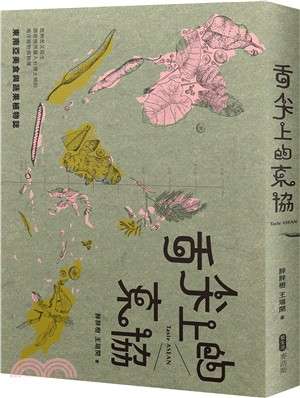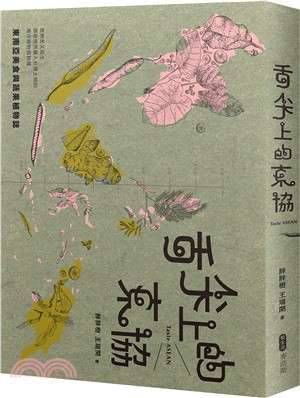ASEAN on the Tip of the Tongue: Southeast Asian Cuisine and Flora: Familiar Yet Unfamiliar: The Plants and Cuisine of Southeast Asia That Have Quietly Integrated into Taiwan
ASEAN on the Tip of the Tongue: Southeast Asian Cuisine and Flora: Familiar Yet Unfamiliar: The Plants and Cuisine of Southeast Asia That Have Quietly Integrated into Taiwan
In stock
Couldn't load pickup availability
ISBN/EAN: 9789864084593
出版日期: 2019-03-14
页数: 320页
语言: Traditional Chinese
From Taiwan's markets, fields, and dining tables,
Getting to know ASEAN
Hidden in the alleys of Taiwan are a plethora of exotic flavors: Thai cuisine, Vietnamese restaurants, Burmese eateries, Indonesian fare...you'll find authentic eateries everywhere, making you savor their delicious flavors. These restaurants appear to have been around for a long time, perhaps even over a decade. The owners often hail from the cuisine's birthplace and speak with a thick accent. Then there are the unfamiliar products displayed at stalls in places like ASEAN Plaza, Huaxin Street Market, and Zhongzhen Market—these are supposedly emerging Southeast Asian herbs and fruits. When and how did these cuisines take root in Taiwan?
If flavor is the key to human memory, then hometown cuisine is the remedy for homesickness. To savor the flavors of home in a foreign land, early immigrants brought a few easily grown herbs and vegetables from their hometowns, planting them like flowers in pots on balconies, rooftops, or in the yard. Over the decades, through food, from Vietnamese, Thai, Burmese, and Indonesian cuisines, it has quietly become an integral part of Taiwanese culture.
How do you order dishes in Indonesian and Filipino restaurants? What are some advanced Vietnamese dishes? Is Burmese cuisine disguised as Thai cuisine? Pang Pang Shu begins by exploring the cuisine, history, and culture of ASEAN countries, then returns to representative Southeast Asian markets and settlements across Taiwan to discover the flavors of ASEAN. Interspersed throughout the book are over one hundred plant illustrations, explaining the ecological characteristics, consumption, and uses of these Southeast Asian fruits, vegetables, and spices. He hopes to share his understanding of ASEAN through the lens of food and plants, from the market, the fields, and the dining table.
Fat Tree Wang Ruimin
A writer, illustrator, and tropical rainforest plant enthusiast. His motto is, "If I could only do one thing well in my life, it would be to leave behind more living cultural heritage for Taiwan (tropical plants)." Since childhood, he's dreamed of creating a tropical rainforest botanical garden. To realize his dream, he's been constantly researching relevant information and literature since college, while searching for lost tropical rainforest plants throughout Taiwan. He also shares his records of these plants on Facebook and his blog, "Pangpangshu's Tropical Rainforest." To raise funds for his dream, he worked at a real estate agency for five years after graduating from the National Taiwan University Forestry Research Institute. At the age of 30, driven by his desire to share his dream with more people, he decided to become a writer. In 2018, he completed his first book, the 180,000-word illustrated book, "The Invisible Rainforest: Flora of the Formosa Rainforest." His second book, "A Taste of ASEAN: Flora of Southeast Asian Cuisine and Fruits," was published in 2019.
[Tropical Rainforest of Fat Trees]
"Pang" (Fat) is composed of the characters for "half" and "moon." A tree is a slow-growing life form. Naming myself "Pang Pang Shu" reminds me that life is often imperfect, and warns me against complacency. It also challenges me to be as patient as a tree, learning and growing day by day, albeit slowly. Just like the commitment I've made to my dream over the past decade, despite facing incomprehension and numerous obstacles, I persevere, hoping that one day, the two characters "Pang" (Fat) will become a bright moon.
Blog: https://raywang1016.pixnet.net/blog
Facebook: Fat-Fat Tree Tropical Rainforest
Line: @uyx0329r (Share information about Pangpangshu’s lectures, events, etc.)
book:
The Invisible Rainforest: Flora of the Formosa Rainforest: How Rainforest Plants Brought to Taiwan by Oceans Take Root and Construct Our History, Civilization, and Daily Life
‧Openbook 2018 Best Books for a Better Life‧Books.com.tw 2018 Book Selection
Related book: "The Invisible Rainforest: Flora of the Formosa Rainforest: How Rainforest Plants Brought to Taiwan by Oceans Take Root, Constructing Our History, Civilization, and Daily Life"
Introduction, Southbound Policy 2.0: A Brief History of the Introduction of Southeast Asian Spices, Fruits, Vegetables, and Food Culture to Taiwan
[PART 1 Dietary Characteristics of ASEAN Countries]
1. From Zheng He's voyages to the Age of Discovery
1. Sago
2. Atap
2. ASEAN Unrest: Southeast Asia and Spice Plants
3.Fake Konjac
4. Spiny Coriander
3. Miss Saigon and Bai Xia – Vietnam
5. Vietnamese Baixia
6. Wood turtle fruit
7. Red Silk Thread
8. Acuminate
4. Tomb Raider at Angkor Wat – Cambodia
9. Four numbers of trees
10. Tamarind
5. I saw Tom Yum in "Foreign Land" - Thailand and Laos
11. White Jade Pill
12. Jackfruit
13. Durian honey
14. Mengjian
15. Rambutan
16. Throwing leaves
17. Butterfly Pea
6. Kokang lifts the veil of Myanmar
18.Curry leaves
7. The Taste of Malacca and Nyonya – Malaysia, Singapore, and Brunei
19. Malacca Tree
20.Baca fruit
8. Spice Islands: Indonesia
21. Stone chestnut
22. Lemon leaves
9. Don’t Call Me Maria – Philippines
23. Rouge
COLUMN is a common plant in Southeast Asia in daily life
[PART 2: Finding the Taste of ASEAN in Taiwan]
10. An ASEAN Explanation: Taichung ASEAN Plaza
24. Stinky Beans
25. Albizia julibrissin
26. Sesbania grandiflora
27. Sesbania tianxia
28. Water Lily
29. Thai Cucumber
30. Vietnamese Dream Grass
31. Swamp chrysanthemum
32. Guess
33. Sand Pear Olives
34. Java Quince
35. Hairy Durian
36. Sapodilla
37. Milk Fruit
38. Kumquat
39. Shantuoer
40. Thai peppercorns
11. Pandan Meatballs from Taipei to Beijing – Indonesian Street at Taipei Main Station
41. Pandan
42. Ni Tengguo
43. Saran leaf
44. Lanza fruit
45. Olives
12. Don’t try on wedding dresses today – Little Manila on Zhongshan North Road in Taipei
46. Banana
13. The End of the Vietnam War: Muzha Vietnam Street
47. Lemon Basil
48. Laksa Leaves
49. Vietnamese Mao Weng
50. Houttuynia cordata
14. A Microcosm of Myanmar: Zhonghe Huaxin Street
51. Mudun Fruit
52. Chinese Melia azedarach
53. Burmese stink beans
54. Roselle
55. Acacia vine
56. Brown corn
57. Snow Swallow
58. Ao Da Cup 15, Thai Street is not Thai - Taoyuan Hou Train Station and Zhongli Train Station
59. Small round eggplant
60. Yellow ash
61. Sweet potato
62. Grass Pepper
63. Southern Beet Tree
64. Ya Nang Ye
65. Neem
66. Big night-blooming jasmine
16. From Duan Yu’s hometown: Zhongli Longgang Zhongzhen New Village
67. Bitter Sign
68. Fennel root
69. Cassava Leaves
70. Wood Butterfly
71. Peeled Cabbage Root
72. Pheasanthemum villosum
73. Moringa
17. Upper Lancang River - Longtan Gancheng Village
74. Stinky Vegetables
75. Gonggong wood
76. Button Eggplant
77. Twin Vegetables
18. If I Came from Xishuangbanna—Pingtung Ligang Xinguo Community
78. Chicken Feet Vegetable
79. Hairy Snake Vine
80. Glutinous Rice Fragrance
81. Goat Milk Fruit
82. Indian Gooseberry
19. Gongguan, the first forgotten street in Southeast Asia
83. Lemongrass
84. Turmeric
85. Galangal
20. Visible migrant workers, invisible new immigrants
86. Vietnamese potatoes
87. Tree Spinach
88. Java Sesbania
89. Durian
90. Blue Ginkgo
91. Grape mulberry
92. Salak
93. Torch Ginger
94. Sand ginger
95.Thai Black Ginger
96. Indonesian Aiyu
97. Spiny Taro
98. Emperor Wulan
21. Familiar yet unfamiliar Nanyang flavor
99. Leucaena
100. Gotu Kola
101. Passing Changsha
102. Dried flower fig
103. Pepper
104.Lily leaves
105. Kapok
106. Monkey Fruit
107. Nutmeg
108. Lilac
109. Spearmint
110. Vietnamese Mint
111. Melissa officinalis
112. Perilla
COLUMN Southeast Asian Cuisine Recommendations Appendix Plant Names and Usage Table
Share


